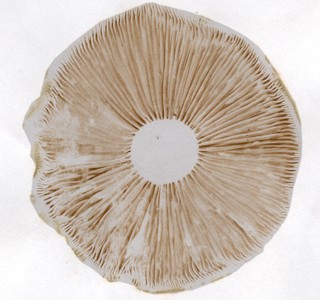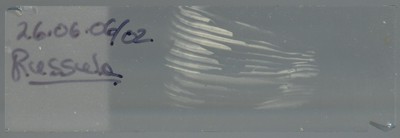Home >> Diversity and classification >> True fungi >> Dikarya >> Basidiomycota >> Agaricomycotina >> Mushrooms and boletes >> Mushrooms
MUSHROOMS
Fungi reproducing by means of mushrooms belong mainly to the order Agaricales, with a smaller but significant number in the Russulales. They have been studied intensively for the last 200 years but are still not as thoroughly classified as plants, birds, mammals and other large organisms. Finding a new species of bird anywhere in the world is cause for excitement but a new species of mushroom, even in the most populated parts of Europe is routine. Part of the reason for this is the great number of mushroom species; while there are only a few hundred bird species in all of North America there are literally thousands of mushrooms. Add to this the fact that ornithologists greatly outnumber mycologists and it becomes obvious that much work is left to be done.
The study of mushrooms goes back hundreds of years but became more systematized by the pioneering work of the Swedish mycologist Elias Fries. Fries, working in the first half of the 19th century, set up a system of classification for mushrooms that was so ingenious that it is still largely in use today. Its foundations have even survived the upheavals of modern genetics.
 The fundamental structure of this system is based on the colour of basidiospores when the are viewed in mass. To do this one obtains a spore print of the mushroom by placing the pileus (cap), lamella (gill) side down on white paper, so that the spores will fall down to collect in a powdery mass. Its usully helpful to cover the pileus with a bowl so that it doesn't dry out, and also to prevent stray air currents from blowing the spores around. The picture at left is a simple scan of a spore print made by putting the pileus of Cortinarius armillatus on a white piece of paper and leaving it overnight. The result is remarkable; not only are the lamellae defined by the spores they produced but even where they are bent is preserved. This is a photograph in spores.
The fundamental structure of this system is based on the colour of basidiospores when the are viewed in mass. To do this one obtains a spore print of the mushroom by placing the pileus (cap), lamella (gill) side down on white paper, so that the spores will fall down to collect in a powdery mass. Its usully helpful to cover the pileus with a bowl so that it doesn't dry out, and also to prevent stray air currents from blowing the spores around. The picture at left is a simple scan of a spore print made by putting the pileus of Cortinarius armillatus on a white piece of paper and leaving it overnight. The result is remarkable; not only are the lamellae defined by the spores they produced but even where they are bent is preserved. This is a photograph in spores.
 Of course the colour of the spores is what we want and in this case we can clearly see that they are brown, just as Fries did 200 years ago. A variation is seen in the picture at right. Here a portion of the pileus of a species of Russula was placed on a microscope slide and covered for a few hours. In this species the spores are light yellow. Spore colours can range from pure white to pure black. In between are shades of yellow, brown, pink and purple. In the system devised by Fries mushrooms are divided into five groups according to spore colour. These colour groups are 1) white to yellow, 2) pink, 3) ochre-brown, 4) rusty-brown, and 5) purple-brown to black. The shades of brown noted by Fries were not always useful and he turned to other features to sort these groups out.
Of course the colour of the spores is what we want and in this case we can clearly see that they are brown, just as Fries did 200 years ago. A variation is seen in the picture at right. Here a portion of the pileus of a species of Russula was placed on a microscope slide and covered for a few hours. In this species the spores are light yellow. Spore colours can range from pure white to pure black. In between are shades of yellow, brown, pink and purple. In the system devised by Fries mushrooms are divided into five groups according to spore colour. These colour groups are 1) white to yellow, 2) pink, 3) ochre-brown, 4) rusty-brown, and 5) purple-brown to black. The shades of brown noted by Fries were not always useful and he turned to other features to sort these groups out.
We still use spore prints today to help identify our mushrooms and combine these results with other features that will be useful. A more in-depth discusssion of mushrooms is offered in the essay Collecting Mushrooms For Scientific Study. A quick overview follows.
WHITE TO YELLOW SPORES

Above are two members of the Russulales, Russula peckii and Lactarius deterrimus. Both have characteristic basidiospores with amyloid ridges and spines and both have tissues containing "nests" of spherical cells called sphaerocysts. Species of Russula are often brightly coloured. The bright red and rather stiff basidiomata of R. peckii identify it as a typical Russula species. Lactarius species frequently have lamellae that extend some distance down the stipe (stalk), a condition described as decurrent. They are also characterized by the production of a liquid that oozes from the cut flesh. In the case of L. deterrimus the "latex" is orange, but in other species it can be white, yellow, purple or even blue.

Many members of the Agaricales have white spores. Four species common in New Brunswick are, left to right, Amanita flavoconia, a species forming mycorrhizae with conifers, Xeromphalina campanella, a common decomposer of conifer wood, Hygrocybe cantharellus, a species decomposing wood and woody litter in hardwood forests and Gymnopus acervatus, another decomposer of spruce and fir wood. The fruiting bodies of G. acervatus usually occur in dense clusters containing dozens of individual basidiomata.
PINK SPORES

There are fewer pink-spored mushrooms than ones with other spore colours, but one group, the genus Entoloma is nevertheless large and difficult. The picture above shows three species of Entoloma and one of the smaller genus Pluteus. Entoloma incanum, at far left, is a species of hardwood forests recognized by the blue-green colours in its fruiting bodies. It also has a peculiar odour of mouse urine that is otherwise not known in mushrooms. The next species is E. quadratum, a salmon-coloured mushroom with a peaked cap, followed by E. abortivum. Entoloma abortivum is thought to be parasitic on the fruiting bodies of certain Armillaria species and to reduce them to formless white masses like the one in the leftmost part of the picture. The whole fruiting bodies of E. abortivum have an odour of wet flour or cucumbers. All species of Entoloma have basidiospores marked by facets similar to those on a cut diamond. Most have many facets, but E. quadratum has only six, resulting in a cube-shaped spore. The picture at far right is of Pluteus longistriatus, a decomposer of wood, with fruiting bodies that smell like radishes. The lamellae in Pluteus species do not reach the stipe, resulting in a clear ring where the stipe meets the pileus. You may have noticed that all but one of these mushrooms have characteristic odours. In fact the odours of mushrooms are exceedingly varied and are important in identification.
BROWN SPORES

Species with brown basidiospores, such as those figured above, are common throughout the Agaricales. At far left is Cortinarius traganus, a very common species forming mycorrhizae with spruce and fir in our area. It is recognized by its purple cap and stipe as well as by its odour of dried pears or apples. Cortinarius is the largest genus of all mushrooms, with more than 2000 described species and many more yet to be discovered. In addition to the brown spores, species of Cortinarius are recognized by the fibrous veil, called a cortina, connecting the margin of the pileus to the stipe. The middle photograph shows fruiting bodies of Galerina marginata growing in the grass of a cemetary near Schefferville, Quebec. This highly poisonous little mushroom usually grows on rotting logs, but may also occur on buried wood, as is probably the case in the one shown here. The picture at right is of Pholiota squarrosa, a species that can form immense clusters on rotting logs. The large upright scales on the pileus and stipe distinguish this species from most other Pholiota species. In our region the fruiting bodies of this species often smell like coffee.
PURPLE-BROWN TO BLACK SPORES

Many of the species of Agaricales with very dark spores occur in open areas such as grasslands where their spores may be exposed to high amounts of solar radiation. Not surprisingly, really dark spores are rare, or maybe absent, in mycorrhizal species that of necessity occur in shaded places under trees. The pictures above show four such species. In the left panel is a cluster of Coprinopsis atramentaria fruiting bodies. This species occurs in lawns and other open areas. It is one of the "inky-cap" mushrooms that have lamellae that dissolve at maturity into a wet inky mass. The next pricture is of Panaeolus retirugis, a species that grows in meadows, lawns and grasslands. These particular mushrooms were found on Sable Island, Nova Scotia, in sandy soil well-fertilized by horse manure. The next mushroom also comes from Sable Island. This one, Stropharia semiglobata is growing directly on horse dung. At far right is an inconspicuous little mushroom, Melanotus phillipsii, growing at the base of sedges in a marshy area. Melanotus species differ from the other species in this set in having an excentric stipe, that is, the stipe does not arise at the centre of the pileus but more off to the side. Excentric stipes are common among species that grow on vertical surfaces where it is necessary to keep the pileus away from the substrate.